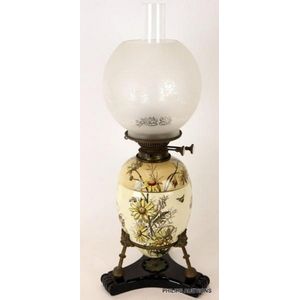Victorian George Jones Ceramic Oil Lamp with Bumble Bees
A Victorian brass mounted ceramic oil lamp, attributed to George Jones, circa 1885, the glazed earthenware font and ovoid body transfer decorated with bumble bees flying amongst yellow daisies in the aesthetic style, supported by three mask and ball legs on a triform ceramic base, printed 'rd no 826' to the inside of the body, complete with a chimney and a frosted glass shade decorated with scrolls; a similar example in the collection of the Geffrye Museum, London. Height 57 cm
You must be a subscriber, and be logged in to view price and dealer details.
Subscribe Now to view actual auction price for this item
When you subscribe, you have the option of setting the currency in which to display prices to $Au, $US, $NZ or Stg.
This item has been sold, and the description, image and price are for reference purposes only.
- Earthenware - A basic ceramic material that is fired at a low temperature. Earthenware is the basis of almost all ancient, medieval, Middle Eastern and European painted ceramics. After firing, the colour is the colour of the clay when it is dug from the ground: buff, brown and red. It is not waterproof until glazed. Creamware is a type of earthenware covered with a transparent lead glaze. Majolica, faience and delft are also earthenware covered in an opaque white tin glaze.
- Registered Numbers - Between 1842 and 1883, a diamond- shaped mark was used to identify items as British-made, which classified the item according to the material from which it was manufactured, as well as the date of registration. This system was discontinued in 1884 when a numbering system was introduced.
Design registration is for "what and item looks like", and is not a patent ("how something works") or trade mark ("what it is called").
The registered number is usually on an under-surface of an object (on the base of ceramics) and oftern shown as "Rd. No. 99999", sometimes surrounded by a rectangular box.
The table below lists the year, and the first registered number for that year:
1884 1
1885 18,993
1886 39,547
1887 61,207
1888 87,266
1889 111,664
1890 140,481
1891 160,613
1892 183,259
1893 203,348
1894 223,861
1895 244,726
1896 266,237
1897 288,848
1898 309,956
1899 328,527
1900 349,120
1901 367,628
1902 380,979
1903 401,944
1904 422,489
1905 428,004
1906 469,160
1907 486,464
1908 516,375
1909 533,561
1910 546,084
1911 561,570
1912 585,707
1913 608,541
1914 627,887
1915 642,613
1916 651,079
1917 655,001
1918 662,576
1919 665,728
1920 664,869
1921 676,491
1922 685,412
1923 691,571
1924 695,944
1925 705,943
1926 716,386
1927 723,430
1928 725,899
1929 740,459
1930 741,336
1931 757,945
1932 767,110 - Oviform /ovoid - The outline loosely resembling the shape of an egg.
- Victorian Period - The Victorian period of furniture and decorative arts design covers the reign of Queen Victoria from 1837 to 1901. There was not one dominant style of furniture in the Victorian period. Designers used and modified many historical styles such as Gothic, Tudor, Elizabethan, English Rococo, Neoclassical and others, although use of some styles, such as English Rococo and Gothic tended to dominate the furniture manufacture of the period.
The Victorian period was preceded by the Regency and William IV periods, and followed by the Edwardian period, named for Edward VII (1841 ? 1910) who was King of the United Kingdom and the British Dominions and Emperor of India for the brief period from 1901 until his death in 1910. - Circa - A Latin term meaning 'about', often used in the antique trade to give an approximate date for the piece, usually considered to be five years on either side of the circa year. Thus, circa 1900 means the piece was made about 1900, probably between 1895 and 1905. The expression is sometimes abbreviated to c.1900.
- Attributed - A cataloguing term where the item in the opinion of the cataloguers, is a of the period of the artist, craftsman or designer, and which probably in whole or part is the work of that person.
This item has been included into following indexes:
-
kerosene / oil lamps, material
- brass 305
- pottery, porcelain 97
